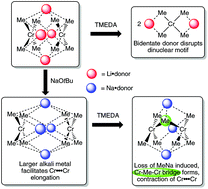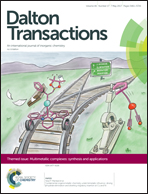Contrasting the group 6 metal–metal bonding in sodium dichromate(ii) and sodium dimolybdate(ii) polymethyl complexes: synthetic, X-ray crystallographic and theoretical studies†‡
Abstract
Extending the class of group 6 metal–metal bonded methylate compounds supported by alkali metal counter-ions, the first sodium octamethylmolybdate(II) complex [(TMEDA)Na]4Mo2Me8 and heptamethylchromate(II) relations [(donor)Na]3Cr2Me7 (donor is TMEDA or TMCDA) are reported. The former was made by treating [(Et2O)Li]4Mo2Me8 with four equivalents of NaOtBu/TMEDA in ether; whereas the latter resulted from introducing TMEDA or TMCDA to ether solutions of octamethyldichromate [(Et2O)Na]4Cr2Me8. X-ray crystallography revealed [(TMEDA)Na]4Mo2Me8 is dimeric with square pyramidal Mo centres [including a short Mo–Mo interaction of 2.1403(3) Å] each with four methyl groups in a mutually eclipsed conformation. In dinuclear [(TMCDA)Na]3Cr2Me7 trigonal bi-pyramidal Cr centres each bond to three terminal methyl groups and one common Me bridge, that produces a strikingly short Cr–Cr contact of 1.9136(4) Å. Broken symmetry density functional theoretical calculations expose the multiconfigurational metal–metal bonding in these compounds with a Mo–Mo bond order of 3 computed for octamethylmolybdate(II). This is contrasted by the single Cr–Cr bond in heptamethylchromate(II) where the singlet ground state is derived by strong antiferromagnetic coupling between adjacent metal ions.

- This article is part of the themed collection: Multimetallic complexes: synthesis and applications


 Please wait while we load your content...
Please wait while we load your content...